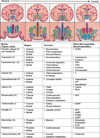Metabolic and Non-Cognitive Manifestations of Alzheimer's Disease: The Hypothalamus as Both Culprit and Target of Pathology
- PMID: 26365177
- PMCID: PMC4654127
- DOI: 10.1016/j.cmet.2015.08.016
Metabolic and Non-Cognitive Manifestations of Alzheimer's Disease: The Hypothalamus as Both Culprit and Target of Pathology
Abstract
Alzheimer's disease (AD) is increasingly recognized as a complex neurodegenerative disease beginning decades prior to the cognitive decline. While cognitive deficits remain the cardinal manifestation of AD, metabolic and non-cognitive abnormalities, such as alterations in body weight and neuroendocrine functions, are also present, often preceding the cognitive decline. Furthermore, hypothalamic dysfunction can also be a driver of AD pathology. Here we offer a brief appraisal of hypothalamic dysfunction in AD and provide insight into an underappreciated dual role of the hypothalamus as both a culprit and target of AD pathology, as well as into new opportunities for therapeutic interventions and biomarker development.
Copyright © 2015 Elsevier Inc. All rights reserved.
Figures



References
-
- Albert MS, DeKosky ST, Dickson D, Dubois B, Feldman HH, Fox NC, Gamst A, Holtzman DM, Jagust WJ, Petersen RC, et al. The diagnosis of mild cognitive impairment due to Alzheimer's disease: recommendations from the National Institute on Aging- Alzheimer‘s Association workgroups on diagnostic guidelines for Alzheimer’s disease. Alzheimers Dement. 2011;7:270–279. - PMC - PubMed
-
- Alzheimer's Association. 2015 Alzheimer's disease facts and figures. Alzheimers Dement. 2015;11:332–384. - PubMed
-
- Ambrée O, Touma C, Görtz N, Keyvani K, Paulus W, Palme R, Sachser N. Activity changes and marked stereotypic behavior precede Abeta pathology in TgCRND8 Alzheimer mice. Neurobiol. Aging. 2006;27:955–964. - PubMed
-
- Ballard C, Corbett A. Agitation and aggression in people with Alzheimer's disease. Curr Opin Psychiatry. 2013;26:252–259. - PubMed
Publication types
MeSH terms
Substances
Grants and funding
LinkOut - more resources
Full Text Sources
Other Literature Sources
Medical
Molecular Biology Databases

